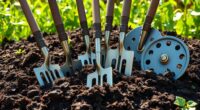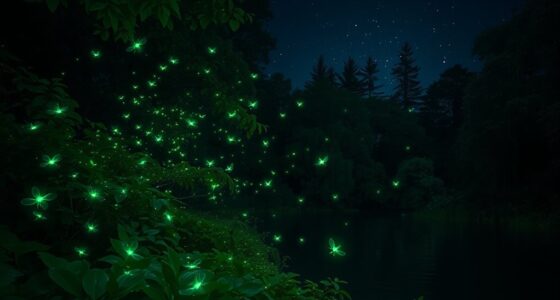Using hedgerows to support beneficial insects involves planting native, diverse species with varying heights and flowering times to provide continuous nectar, shelter, and breeding sites. Proper management includes seasonal planting, minimizing heavy pruning, and regularly monitoring insect populations. Positioning hedgerows near crops creates corridors that enhance biological pest control and pollination. By implementing these strategies, you promote a healthier, more resilient ecosystem—keep exploring further to discover detailed methods for maximizing your hedgerows’ benefits.
Key Takeaways
- Incorporate native, flowering plants with varying heights to provide continuous nectar, shelter, and breeding sites for beneficial insects.
- Design hedgerows as connected corridors to facilitate beneficial insect movement and habitat diversity.
- Avoid dense monocultures; diversify plant species to attract pollinators and pest predators year-round.
- Position hedgerows near crop fields to enhance natural pest control and pollination services.
- Maintain and regularly monitor hedgerows to adapt habitat features and support resilient beneficial insect populations.
Designing Effective Hedgerows for Insect Habitat
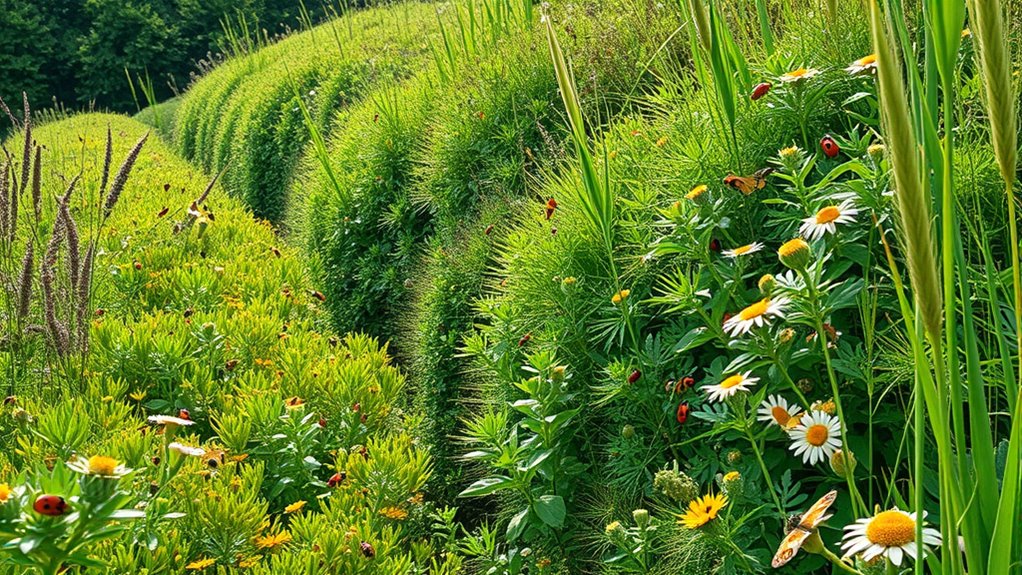
To create hedgerows that effectively support beneficial insects, you need to take into account their structure and plant composition carefully. A well-designed hedgerow provides shelter and nectar sources, which enhance pest control and crop protection. Incorporate a mix of native plants with varying heights and densities to create microhabitats that attract predators and pollinators. Layering the hedgerow—adding shrubs, herbs, and grasses—ensures a continuous supply of resources throughout the growing season. Avoid dense, monoculture plantings that may deter beneficial insects or hinder their movement. By thoughtfully designing your hedgerow, you encourage beneficial insects to thrive, naturally reducing pest populations and supporting healthy crop production. This strategic approach enhances pest control and crop protection sustainably.
Selecting Plant Species to Attract Beneficial Insects
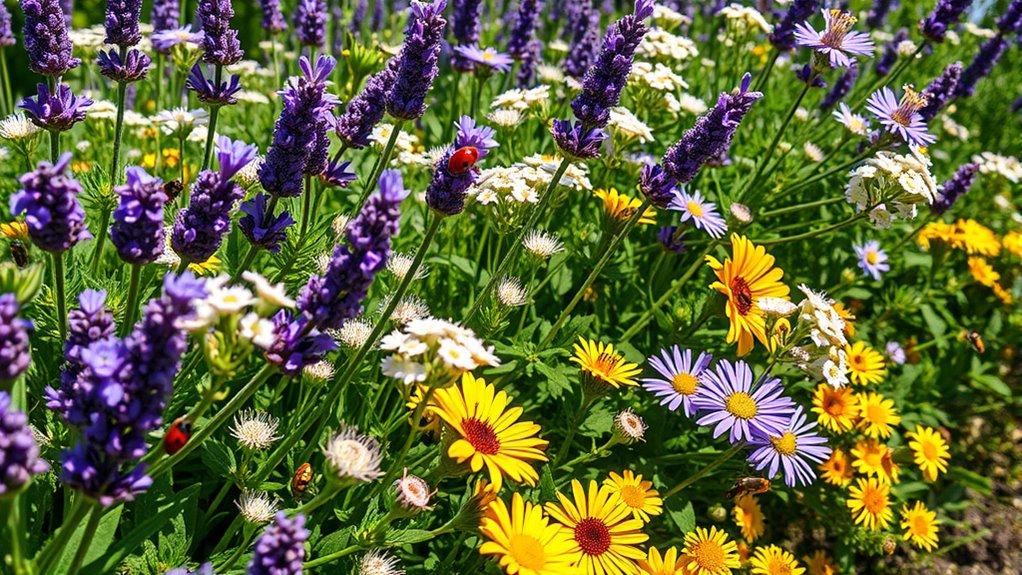
Choosing the right plant species is essential for attracting beneficial insects to your hedgerow. Focus on increasing flower diversity to provide a variety of nectar sources throughout the season. Here are four tips to help you select effective plants:
- Include a mix of flowering plants that bloom at different times to ensure continuous nectar availability.
- Choose native species, as they attract local beneficial insects more effectively.
- Incorporate plants with accessible nectar sources, like open flowers or composite blooms.
- Select a variety of plant heights and structures to provide shelter and foraging opportunities.
- Understanding the importance of contrast ratio can also help you select plants that reflect light effectively, making nectar sources more visible to insects. Additionally, selecting plants with appropriate flower morphology can enhance accessibility for a range of beneficial insects. Incorporating plants with suitable nectar accessibility features ensures that a broad spectrum of insects can efficiently feed and thrive. Considering pollinator preferences can further increase the attractiveness of your hedgerow to beneficial insects. Using beneficial insect habitats can also improve the overall health and diversity of your garden ecosystem.
Managing Hedgerows for Maximum Biodiversity
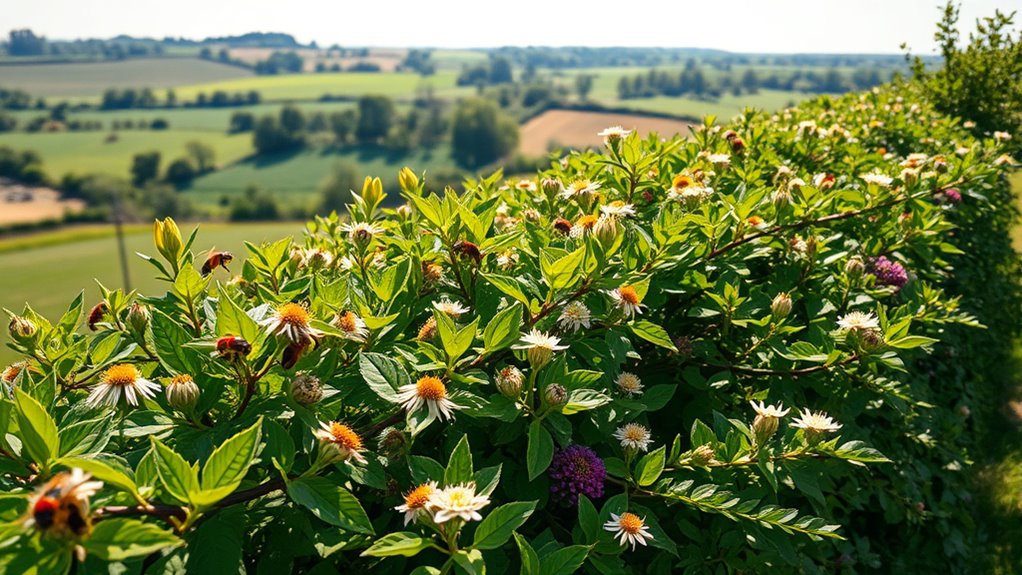
Managing your hedgerows for maximum biodiversity involves strategic practices that support a wide range of beneficial insects, birds, and other wildlife. To enhance pest control and crop protection, diversify plant species within the hedgerow, including flowering plants that attract pollinators and predators of pests. Maintain a mix of native shrubs and trees to provide shelter and breeding sites, ensuring year-round habitat. Avoid heavy pruning and clear-cutting, which can disrupt insect populations. Incorporate layered planting to create microhabitats, helping beneficial insects thrive. Regularly monitor your hedgerow’s health, removing invasive species that threaten native biodiversity. Incorporating diversification strategies can further strengthen ecosystem resilience. These practices are supported by the importance of native plants, which play a vital role in maintaining ecological balance. Additionally, understanding Gold IRA options can inform sustainable investment choices that support long-term ecological and economic stability. Creating protective environments within your hedgerows can also provide safe spaces for beneficial insects to overwinter and reproduce. Including native plant diversity in your hedgerow design promotes greater habitat complexity and resilience. By adopting these practices, you’ll create a resilient, self-sustaining ecosystem that naturally manages pests and boosts crop protection.
Timing and Maintenance Practices to Support Insect Life Cycles
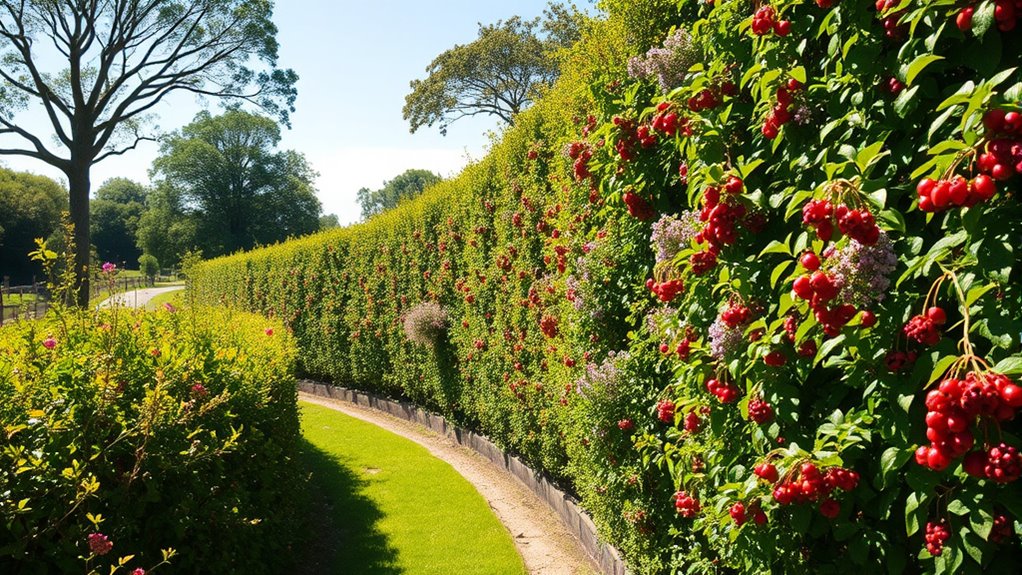
To support beneficial insects, you need to plan your planting and maintenance around their life cycles. Seasonal planting strategies guarantee food sources are available when insects need them most, while proper pruning creates habitats that encourage nesting and shelter. By timing your habitat management practices carefully, you can enhance the longevity and effectiveness of beneficial insect populations. Incorporating visual and auditory cues into your habitat management can also promote better understanding and support for these insects. Additionally, understanding integrated pest management principles can help you minimize chemical use and foster a healthy environment for beneficial species. Recognizing the importance of pollination services can further motivate the preservation of habitats that support beneficial insects. Implementing environmentally friendly practices ensures the sustainability of beneficial insect populations for future seasons.
Seasonal Planting Strategies
Have you considered how timing your planting and maintenance practices can considerably boost beneficial insect populations? Proper seasonal planting ensures insects are active when pests are most vulnerable. Here are key strategies:
- Plant early in spring to support pollinators and natural pest control agents during critical crop growth stages.
- Stagger plantings throughout the season to provide continuous food sources for beneficial insects.
- Incorporate diverse flowering plants that bloom at different times, aiding crop diversification and attracting beneficial insects year-round.
- Avoid heavy pruning during peak insect activity, allowing habitats to flourish and sustain insect populations.
- Understanding risk assessment helps in planning planting schedules that minimize exposure to threats and support healthy beneficial insect communities. Additionally, selecting appropriate plant varieties that are native or well-adapted can enhance habitat suitability for beneficial insects.
- Recognizing the importance of timing in planting can help synchronize beneficial insect activity with pest emergence, maximizing natural pest control efforts. Implementing seasonal planting strategies that align with insect life cycles further optimizes these benefits.
Pruning and Habitat Management
Timing your pruning and habitat maintenance can substantially influence beneficial insect populations. Pruning hedgerows at appropriate times guarantees that overwintering insects aren’t disturbed during critical life stages, supporting natural pest control. Avoid heavy trimming during peak insect activity to maintain habitat stability. Regular habitat management, such as removing debris and invasive plants, helps preserve a healthy environment for beneficial insects. Incorporating crop rotation strategies nearby to reduce pest populations naturally, minimizing chemical use. Proper timing also prevents disrupting insect life cycles, allowing beneficial species to reproduce and establish. Using climate control strategies can further optimize habitat conditions for beneficial insects, ensuring they remain active and resilient. Additionally, maintaining diverse plant species within your hedgerows provides essential resources and habitat diversity that support a wide range of beneficial insects. By maintaining your hedgerows thoughtfully, you create a resilient habitat that supports pest control and enhances overall crop health through sustained beneficial insect activity.
Integrating Hedgerows Into Sustainable Farming Systems
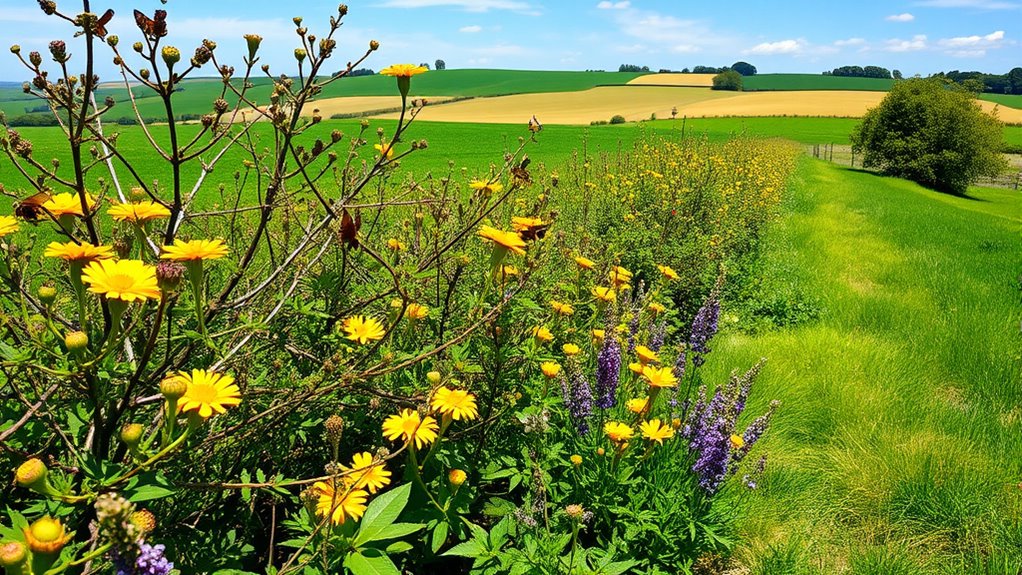
Integrating hedgerows into sustainable farming systems offers a practical way to enhance biodiversity and promote ecosystem health. By thoughtfully placing hedgerows, you can naturally improve pest control and crop pollination. Consider these key strategies:
- Position hedgerows near crop fields to attract beneficial insects that prey on pests.
- Use native plants to support diverse beneficial insect populations.
- Incorporate flowering plants that bloom throughout the season to ensure continuous food sources.
- Design hedgerows as corridors, linking fragmented habitats and facilitating insect movement.
This integration reduces reliance on chemical controls, boosts pollination efficiency, and creates resilient farm ecosystems. By aligning hedgerow placement with your crop layout, you optimize benefits, making your farm more sustainable and productive.
Monitoring and Evaluating Insect Populations in Hedgerows
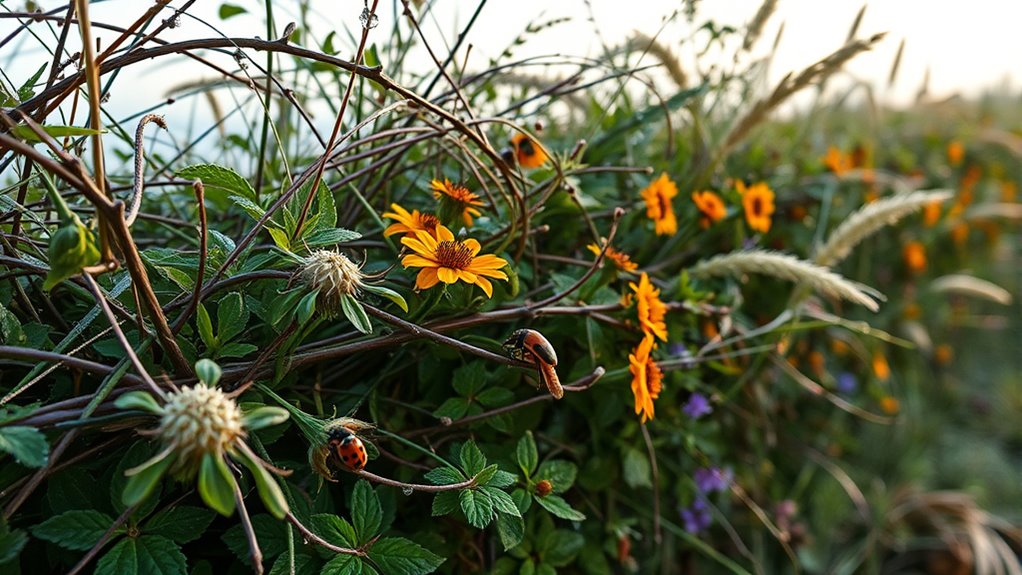
To guarantee that your hedgerows effectively support beneficial insect populations, regular monitoring and evaluation are essential. Use targeted population sampling methods, such as sweep nets or pitfall traps, to assess insect diversity and abundance. Incorporate insect attractants like floral scents or nectar sources to draw beneficial insects for easier observation. Tracking changes over time helps you identify which plants or features attract and sustain beneficial insects. Record your findings systematically to evaluate the success of your hedgerow management strategies. Consistent monitoring allows you to detect declines or increases in beneficial insect populations promptly. Adjust your practices based on these insights, ensuring your hedgerows remain a vibrant habitat that continuously supports beneficial insects for natural pest control and pollination.
Frequently Asked Questions
How Do Hedgerows Affect Overall Farm Biodiversity Beyond Beneficial Insects?
Hedgerows boost farm biodiversity by creating wildlife corridors that connect habitats, allowing animals and plants to thrive. They improve soil health through organic matter and root systems that prevent erosion. Beyond beneficial insects, they support birds, small mammals, and pollinators, enhancing ecological balance. You’ll find that these natural features increase resilience, promote sustainable farming, and foster a richer, more diverse ecosystem on your farm.
Can Hedgerows Help Control Pest Populations Naturally?
Pest predation is a powerful tool in natural pest control, and habitat complexity plays a key role. When you plant hedgerows, you create a diverse environment that attracts beneficial predators like ladybugs and birds. These predators hunt pests, reducing the need for chemical controls. By fostering habitat complexity, you enhance pest predation, helping you manage pests naturally while supporting a balanced, biodiverse farm ecosystem.
What Are the Costs Associated With Establishing and Maintaining Hedgerows?
When considering the costs of establishing and maintaining hedgerows, you should conduct a thorough cost analysis to understand expenses involved. Initial setup can be significant, covering planting, fencing, and site preparation. Maintenance challenges include pruning, controlling invasive species, and managing pests. While costs vary depending on size and plant choices, investing in hedgerows offers long-term benefits like supporting beneficial insects, which can naturally reduce pest populations and improve overall farm health.
How Do Climate Changes Impact the Effectiveness of Hedgerows for Insects?
Imagine your hedgerows as brave little soldiers, fighting climate chaos. Climate change tests their climate resilience, making it harder for them to provide stable habitats. As weather patterns shift and temperatures soar or plummet unpredictably, their ability to adapt diminishes. You’ll find that without proper habitat adaptation, hedgerows struggle to support beneficial insects, risking their role as essential allies in your garden’s ecological balance.
Are There Specific Legal Regulations for Planting and Managing Hedgerows?
When it comes to planting and managing hedgerows, you need to guarantee legal compliance by following local planting regulations. These regulations may specify the types of plants allowed, hedge height, and maintenance practices to protect biodiversity and land use. Check with your local authority or environmental agency to understand specific rules. Staying compliant helps you support beneficial insects while avoiding potential legal issues and promoting sustainable land management.
Conclusion
Think of your hedgerows as busy insect hotels, buzzing with life and purpose. When you choose the right plants and maintain them well, you create a thriving ecosystem that supports beneficial insects—nature’s pest controllers and pollinators. Just like a well-tended garden yields bountiful harvests, a thoughtfully managed hedgerow can transform your farm into a vibrant, balanced landscape. Your efforts turn a simple hedge into a powerful tool for sustainable farming and healthy ecosystems.

